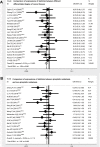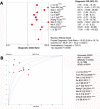Overexpression of stathmin promotes metastasis and growth of malignant solid tumors: a systemic review and meta-analysis
- PMID: 27806343
- PMCID: PMC5346693
- DOI: 10.18632/oncotarget.12982
Overexpression of stathmin promotes metastasis and growth of malignant solid tumors: a systemic review and meta-analysis
Abstract
Stathmin has been investigated to be involved in development and progress of malignant tumors. This study was to clarify the relationship between expression of stathmin and tumors and assess its clinical significance. We identified 25 studies with a total of 3,571 individuals from the electronic bibliographic databases and strictly evaluated the quality and heterogeneity of included studies. We analysed the relationship between expression of stathmin and clinical characteristics by the fixed-effects and random-effects of meta-analysis and constructed a summary receiver-operator characteristic curve to estimate the test characteristics. The results showed that patients with cancer displayed a higher stathmin expression than those of non-cancer individuals (OR, 0.31), and overexpression of stathmin correlated with tumor cell differentiation (OR, 0.73), lymph node invasion (OR, 0.80) and high TNM stage (OR, 0.67). The pooled sensitivity of stathmin for distinguishing malignant tumors was 0.73 and the specificity was 0.77. The maximum balance joint for sensitivity and specificity (the Q-value) was 0.7566 and the area under the curve (AUC) was 0.8234. In conclusion, these results showed that overexpression of stathmin intimately correlated with malignant behavior of tumors, suggesting it could be a risk factor of malignant tumors. Stathmin had great sensitivity and specificity indicated it should be a significant molecular biomarker for malignant tumors.
Keywords: diagnosis; immunohistochemistry; meta-analysis; stathmin; tumors.
Conflict of interest statement
The authors declare no conflicts of interest.
Figures






References
-
- Siegel RL, Miller KD, Jemal A. Cancer statistics, 2015. CA Cancer J Clin. 2015;65:5–29. - PubMed
-
- Chen W, Zheng R, Baade PD, Zhang S, Zeng H, Bray F, Jemal A, Yu XQ, He J. Cancer statistics in China, 2015. CA Cancer J Clin. 2016;66:115–132. - PubMed
-
- Chen G, Jundong GU, Chen J, Liu Y, Song Z. Association between clinical pathology and multiple genes mRNA expression in Chinese patients with NSCLC. J Cancer Res Ther. 2013;9:S98–100. - PubMed
-
- Ng DCH, Byrne F. Cytoskeleton and Human Disease. Springer; 2012. Stathmin and Cancer; pp. 259–284.
-
- Rana S, Maples PB, Senzer N, Nemunaitis J. Stathmin 1: a novel therapeutic target for anticancer activity. Expert Rev Anticancer Ther. 2008;8:1461–1470. - PubMed
Publication types
MeSH terms
Substances
LinkOut - more resources
Full Text Sources
Other Literature Sources
Miscellaneous

